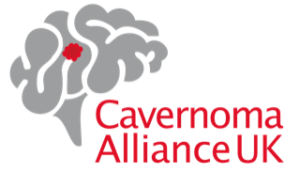Stereotactic Radiosurgery
Stereotactic Radiosurgery (SRS) is a treatment option for people with symptomatic cavernoma. It uses precisely focused radiation to target the cavernoma without the need for an incision. SRS is typically considered for smaller, deep-seated, or surgically high-risk cavernomas.
What is stereotactic radiosurgery?
Currently, the NHS offers two treatment options for symptomatic cavernoma alongside a ‘wait and see’ (or conservative medical management) approach: neurosurgery or stereotactic radiosurgery.
Stereotactic radiosurgery (SRS) is typically considered for smaller deep-seated or surgically high-risk cavernomas, where neurosurgery would carry greater danger. It uses focused radiation to target specific areas in the brain without needing to make any cuts or incisions. Gamma Knife is one of the most common forms of this treatment, using highly focused beams of gamma radiation to treat conditions like cavernomas.
Despite the name, there’s no actual ‘knife’ involved – it’s a painless procedure usually done in a single session. It does not involve incisions or general anaesthesia. Instead, multiple beams of radiation converge on the targeted area, delivering a high dose of radiation while minimizing exposure to surrounding healthy tissue.
The radiation damages the DNA within cavernoma cells, preventing them from reproducing, and may help reduce the risk of future bleeds over time. However, the cavernoma itself is not removed, and the effects of the treatment can take up to two years to fully develop.
To ensure accuracy, the person’s head is kept completely still during treatment. Depending on the centre, this might involve a head frame or a custom-fitted mask.
SRS remains a topic of ongoing research and discussion among specialists. It has not yet been proven effective through a large clinical trial beyond the CARE pilot study, so there is still some uncertainty about how well it works and for whom it is most suitable. Decisions about SRS should always be made in discussion with your neurosurgeon or neurologist, taking into account your individual situation.

For a more in-depth understanding of cavernoma treatments, you can explore our YouTube channel, where clinicians and people with cavernoma provide further insights.
What does the research say?
Between August 2021 and January 2024, the ‘Cavernomas: A Randomised Effectiveness (CARE) Study’ took the first step to working out whether treatment of brain cavernoma with medical care and surgery (using either neurosurgery or stereotactic radiosurgery) reduces the risk of a stroke compared to medical care alone.
During follow-up, 2 out of 33 people treated with surgery (neurosurgery or stereotactic radiosurgery) had a stroke, compared with 2 out of 34 people who received medical care alone. This highlights that both treated and untreated people carry risk, and that more evidence is needed. You can read more about the CARE trial by visiting https://cavernoma.org.uk/care-study/
You can learn more about SRS and cavernoma in this recording featuring Mr Mattias Radatz – Consultant Neurosurgeon based at The National Centre for Stereotactic Radiosurgery in Sheffield.
Preparations and recovery
Stereotactic radiosurgery (SRS) is an outpatient procedure, which means preparation and recovery are more straightforward than with neurosurgery. Before the procedure, your care team will explain what to expect, including how your head will be kept still (using either a head frame or a custom-fitted mask) and what the session will involve. You may wish to bring someone with you for support.
In most cases, SRS is done as a day-case procedure, and you won’t need to stay overnight in hospital. The treatment usually lasts a few hours, and after a short period of observation, most people are able to return home the same day. Occasionally, an overnight stay may be recommended – for example, if there are other health factors your team wishes to monitor.
Recovery after SRS is usually good, though experiences can vary. Some people feel tired or have mild headaches for a few days, while others report no side effects at all. It’s a good idea to take it easy for the first couple of days, but many people are able to resume normal activities quite quickly.
Unlike surgery, SRS does not remove the cavernoma – it works gradually over time to reduce the risk of bleeding. Follow-up scans are typically scheduled months later to monitor any changes. As always, speak to your clinical team if you have any questions or concerns before or after your treatment.
UK availability
Stereotactic radiosurgery for cavernoma has been available for some years at the following two specialised centres:
- National Hospital for Neurology and Neurosurgery (NHNN), London: Located in Queen Square, NHNN is a leading centre for neurology and neurosurgery.
- Royal Hallamshire Hospital, Sheffield: This regional hospital is the specialist neurosurgery and neurology centre for South Yorkshire and was the first to have a Gamma Knife centre established in the UK in 1985.
In 2025, it was also commissioned and made available at two more specialised centres:
Your Neurosurgeon will discuss all treatment options with you and if stereotactic radiosurgery is recommended then they will refer you to one of these specialised centres.
